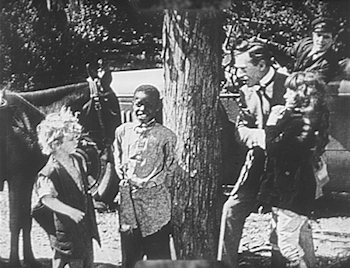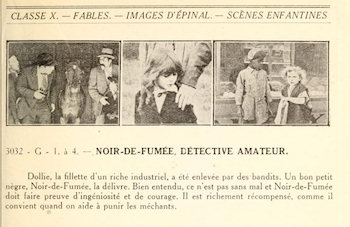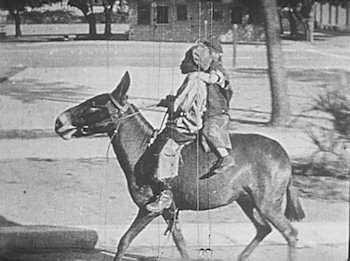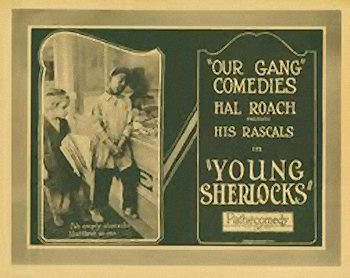Noir-de-Fumée, Détective Amateur (?, 1931)
 Noir-de-Fumée, Détective Amateur (?, 1931)
Noir-de-Fumée, Détective Amateur (?, 1931)
Directed by ?
Starring ?
To address the question marks, rather than posting in my standard form, I’ve decided to first take you on a little journey:
I mentioned before that I’m in the process of moving and I don’t have most of the film collection at hand. However, quite accidentally one title was left out and it’s been sitting on my make-shift desk for the last three months. It’s on four 60-foot bobbins of 9.5mm film. The title given on the bobbins is Noir-de-Fumée, détective amateur. It appears in the 1931 Pathé-Baby catalogue, item #3032.
But Baby releases were almost always re-titled, so what is this film really? Sometimes the catalogue listing will be of help: it might give the name of the star, or of the director, or rarely it will even reveal the original title. No such luck with Noir-de-Fumée, but there are a few clues. It’s in the children’s film section and is listed as a comedy. Also, it names one of the characters “Dollie”.
My first thought, based solely on this information, was that it’s a Baby Marie Osborne film. Pathé always called Osborne’s characters Dolly or Dollie, regardless of what the characters’ names were originally. The three screenshots are too small to tell who the actors might be, but one of them includes a black boy and that bears out the Osborne theory — Ernest Morrison frequently featured in her films. Trouble is, the description given didn’t match any of the Osborne films I was aware of, and after a quick scan of contemporary release notices and reviews available at lantern.mediahist.org for all of Osborne’s small oeuvre, none of them at all looked like contenders.
So, even if Osborne is out, maybe Morrison is still in. Pathé’s character naming might be an attempt to tie one of Morrison’s later works into his earlier output with Osborne. A Sunshine Sammy film, maybe? I know of them, but I’ve never seen one and I’m not familiar with their plots. Just glancing through a title list, it could be Rich Man, Poor Man (1922) or The Sleuth (1922). Those sound like appropriate titles for a film matching Pathé’s description.
I was leaning towards the Sunshine Sammy idea rather than what Morrison is most remembered for — Our Gang — simply because Noir-de-Fumée doesn’t fit at all with the sort of titles Pathé usually gave Our Gang films. Had it mentioned Négritina or Enfants, then yes, surely Our Gang, but it didn’t.
 You might be asking why am I making this so difficult for myself — why don’t I just look up the item number in the Pathéscope catalogue at pathefilm.uk? That would list the original title along with Pathé’s. That works for earlier films, back when French Pathé-Baby releases and English Pathéscope releases were both printed at the same factory and shared the same item numbers, but not for films of this vintage. Further, Pathéscope mirrored most of Pathé-Baby’s output, but not all of it, and I could find nothing resembling an English version of this title.
You might be asking why am I making this so difficult for myself — why don’t I just look up the item number in the Pathéscope catalogue at pathefilm.uk? That would list the original title along with Pathé’s. That works for earlier films, back when French Pathé-Baby releases and English Pathéscope releases were both printed at the same factory and shared the same item numbers, but not for films of this vintage. Further, Pathéscope mirrored most of Pathé-Baby’s output, but not all of it, and I could find nothing resembling an English version of this title.
Well, that’s as far as I could get without biting the bullet and actually watching the film. Not that I didn’t care to see it, mind, but it was the difficulty of accomplishing this that I was avoiding. As for projecting it, I had my Gem with me, but that’s only for 9.5mm on reels — Noir-de-Fumée, as I said, is in bobbins and my Babies are boxed up. That left transferring it to video. It’s true that the components of my film scanner are here, but setting it up on the two banquet tables squeezed into this small apartment bedroom that I’m calling an office would be a challenge.
I avoided that challenge, as I said, for three months before curiosity won out over laziness. After transferring it, I saw at once that the male lead of the film was indeed Ernest Morrison. He plays Noir-de-Fumée (let’s call him Lampblack instead). The female lead character was called Boby (Bobbie). The Dollie (Dolly) that featured so heavily in the description doesn’t actually feature that heavily in the film. She’s kidnapped almost at once, and after that, she’s just a MacGuffin for Lampblack and Bobbie to rescue. (That’s an anachronism by the way — MacGuffin, I mean. The term more commonly in use in the silent era was weenie.) Dolly certainly isn’t Marie Osborne. Bobbie might have been — kids so young that they’re still chubby with baby fat are hard to tell apart — but I was reasonably sure Bobbie was played by Mary Kornman. That’s two Little Rascals (three actually, but I didn’t right away recognize Dolly as Peggy Cartwright). The Sunshine Sammy theory is looking shaky. The kidnappers are indistinct. A couple of them are in Snub Pollard getups but neither really looked like him otherwise. Paul Parrott was not to be seen, but there is a mule who I bet is named Dinah. The theory falls flat on its face.
Okay, so it’s an Our Gang film. Which one? Not so hard to find: “our gang” + “kidnap” = Young Sherlocks (1922), directed by Robert F. McGowan and Tom McNamara. Young Sherlocks was a very early entry to the Our Gang canon. Indeed, it was one of the first filmed. It was a two-reeler and Noir-de-Fumée is the equivalent of one reel, but the latter doesn’t seem to be severely edited because it’s actually just excerpting the imaginary sequence from Young Sherlocks with only minor edits and presenting it as a stand-alone film. That also explains the absence of the rest of the gang and probably why Pathé downplayed the connection to the series. It wasn’t released by Pathéscope because, in a way, it already had been. Pathéscope turned Young Sherlocks into three separate, much shorter films — Kidnapped, Comrades of the Crimson Clan, and Fun in Freetown — rather than release it in a single, longer form.
Maybe that was more than a “little” journey, but at any rate, we’ve arrived at our destination, so now let me talk about the film:
 Dolly (Peggy Cartwright) is playing on the front lawn with her pony, Spinach, and an unnamed dog. A gang of bandits (Ed Brandenburg, Dick Gilbert, William Gillespie, Wallace Howe, and Mark Jones) appear and kidnap her, expecting to get $100,000 ransom from her rich papa (Charley Young). Across the street, Lampblack (Ernest Morrison) and his little friend Bobbie (Mary Kornman) witness the abduction and decide to intervene.
Dolly (Peggy Cartwright) is playing on the front lawn with her pony, Spinach, and an unnamed dog. A gang of bandits (Ed Brandenburg, Dick Gilbert, William Gillespie, Wallace Howe, and Mark Jones) appear and kidnap her, expecting to get $100,000 ransom from her rich papa (Charley Young). Across the street, Lampblack (Ernest Morrison) and his little friend Bobbie (Mary Kornman) witness the abduction and decide to intervene.
Lampblack and Bobbie follow the getaway car on their mule, Seventy-Five (Dinah). Spinach, who we’re told is a great friend of Dolly, follows as well, independent of the others, and catches up with the bandits first. They send him back with a note to Papa telling him where to bring the money. I imagine this took several takes and I also imagine why, given how cautiously the bandit gives the pony the note and how careful he is not to get his fingers anywhere near his mouth. Papa and Mama (Dot Farley) get the message and speed away in their car, stopping at the bank to withdraw a $100,000, which they seem to consider mere pocket change.
Meanwhile, Lampblack and Bobbie approach the hideout, but suddenly two bandits emerge and now they have to hide themselves. Bobbie squeezes down the barrel of a cannon (the bandits are prepared, we’re told) and Lampblack hides in a stack of cannon balls, his head sticking out the top but perfectly invisible (because he’s black and so are the cannon balls, you see). The bandits have come outside to smoke (polite of them). One tosses his still-lit match inside the cannon, where it lands square on the seat of Bobbie’s pants. As soon as they go back inside, she shimmies out and runs pell-mell across the countryside.
Lampblack sees Dolly tied to a tree, lackadaisically guarded by a bandit who seems to be more interested in the handsome man he sees gazing back at him in his looking glass. Lampblack picks up a shotgun and fires at the bandit, attracting the attention of the others. The kickback launches him into the air, landing on and knocking down one of the other bandits. He shoots again and likewise catapults himself into another.
Bobbie runs to a gas station and sits in a bucket of water. Papa and Mama are there refueling. Dripping wet, she walks over and lets them know where Dolly is being held. They pick her up into the car and speed off without even paying for their gas.
Back at the hideout, the bandits have got the upper hand on Lampblack. He’s backed up against a telegraph pole and they’re throwing swords at him. Every one narrowly misses Lampblack and strikes the pole, eventually causing it to snap in half and come tumbling down on them. Seventy-Five appears to lend assistance, kicking cannon balls at the bandits (he has remarkable aim, you know).
The day is won and Lampblack unties Dolly. Just then, Papa, Mama, and Bobbie pull up. Papa, so pleased with the kids’ efforts, gives them the $100,000, and golly gee, what candy we could buy wit’ all dis dough.
 I’m not big on child comedies, mostly because they star child actors. Mary Kornman doesn’t do much besides stand around and squint. Peggy Cartwright, as I said, is hardly in the film. In the few scenes where she’s not tied up, she does moderately well exhibiting the correct emotion, but her timing is atrocious. I will say, however, that Ernest Morrison is a natural. He acts believably as the kid who starts out on an adventure half-playing pretend and then finds himself in over his head when it gets real (it’s a slapstick comedy, yes, but he does manage to mix in some pathos — he’s the only one who does, in fact, including the adult actors).
I’m not big on child comedies, mostly because they star child actors. Mary Kornman doesn’t do much besides stand around and squint. Peggy Cartwright, as I said, is hardly in the film. In the few scenes where she’s not tied up, she does moderately well exhibiting the correct emotion, but her timing is atrocious. I will say, however, that Ernest Morrison is a natural. He acts believably as the kid who starts out on an adventure half-playing pretend and then finds himself in over his head when it gets real (it’s a slapstick comedy, yes, but he does manage to mix in some pathos — he’s the only one who does, in fact, including the adult actors).
My rating: Without Morrison, I would say dislike, but he elevates it to a solid meh.
Available from Harpodeon
Posted on January 7, 2015, in Meh, Reviews and tagged 1922, 1931, Ernest Morrison, Hal Roach, Mary Kornman, Robert F. McGowan, Tom McNamara. Bookmark the permalink. Leave a comment.
Leave a comment
Comments 0